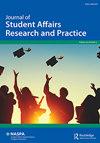Effects of Parasocial Relationships and Identification with TV Characters on Teens
IF 0.8
Q3 EDUCATION & EDUCATIONAL RESEARCH
Journal of Student Affairs Research and Practice
Pub Date : 2023-05-31
DOI:10.47611/jsrhs.v12i2.4314
引用次数: 0
Abstract
With the rise of “binge watching” and increasing use of social media, teens are interacting more with tv shows, or more specifically the characters. Previous research has identified that parasocial relationships (PSR) and identification impact loneliness, body image, and one’s personality and behaviors, but has failed to address the extent to which the effects are positive or negative. PSR and Identification have also not been studied together, despite the likelihood of someone who has formed a relationship with a character to also put themselves in the shoes of said character. My study addressed these gaps and aimed to explore the extent to which the effects of PSR and identification with tv characters are negative on teens ages 14-18. My study also explored the subquestion, are ineffective age-ratings a possible cause of any specific negative effects of PSR and/or identification? I conducted a phenomenological study using a quantitative survey method. I determined participants’ level of PSR and identification with their favorite tv-show character and the number of positive, negative, and neutral effects the phenomenons had on them. A strong correlation between one’s level of PSR and identification confirmed that the two should be studied together. However, no correlation was found between one’s level of PSR or Identification and the positivity or negativity of effects. My subquestion did reveal that PSR and identification pose a problem when with characters from shows rated for an older audience. These findings may have implications on the presence and use of parental controls on television.副社会关系与电视角色认同对青少年的影响
随着“剧迷”的兴起和社交媒体的使用,青少年与电视节目的互动越来越多,或者更确切地说,是与角色的互动。以前的研究已经发现,副社会关系(PSR)和身份认同会影响孤独、身体形象、一个人的个性和行为,但未能解决这种影响的积极或消极程度。PSR和身份认同也没有被放在一起研究,尽管与角色建立关系的人可能也会把自己放在角色的立场上。我的研究填补了这些空白,旨在探索PSR和对电视角色的认同在多大程度上对14-18岁的青少年产生负面影响。我的研究还探讨了子问题,无效的年龄分级是PSR和/或识别的任何特定负面影响的可能原因吗?我用定量调查的方法进行了现象学研究。我确定了参与者的PSR水平和对他们最喜欢的电视节目角色的认同,以及这些现象对他们产生的积极、消极和中性影响的数量。一个人的PSR水平与识别之间的强烈相关性证实了这两者应该一起研究。然而,没有发现一个人的PSR或识别水平与积极或消极影响之间的相关性。我的子问题确实揭示了PSR和识别在针对老年观众的节目中的角色时构成了一个问题。这些发现可能会对家长控制电视的存在和使用产生影响。
本文章由计算机程序翻译,如有差异,请以英文原文为准。
求助全文
约1分钟内获得全文
求助全文
来源期刊

Journal of Student Affairs Research and Practice
EDUCATION & EDUCATIONAL RESEARCH-
CiteScore
2.40
自引率
9.10%
发文量
50
期刊介绍:
The vision of the Journal of Student Affairs Research and Practice (JSARP) is to publish the most rigorous, relevant, and well-respected research and practice making a difference in student affairs practice. JSARP especially encourages manuscripts that are unconventional in nature and that engage in methodological and epistemological extensions that transcend the boundaries of traditional research inquiries.
 求助内容:
求助内容: 应助结果提醒方式:
应助结果提醒方式:


